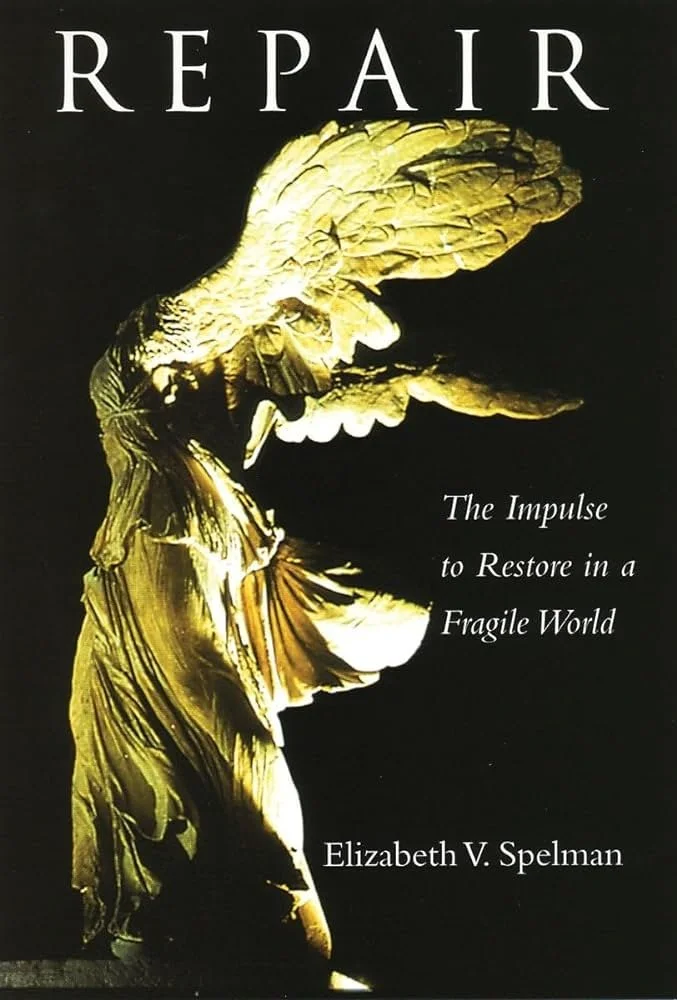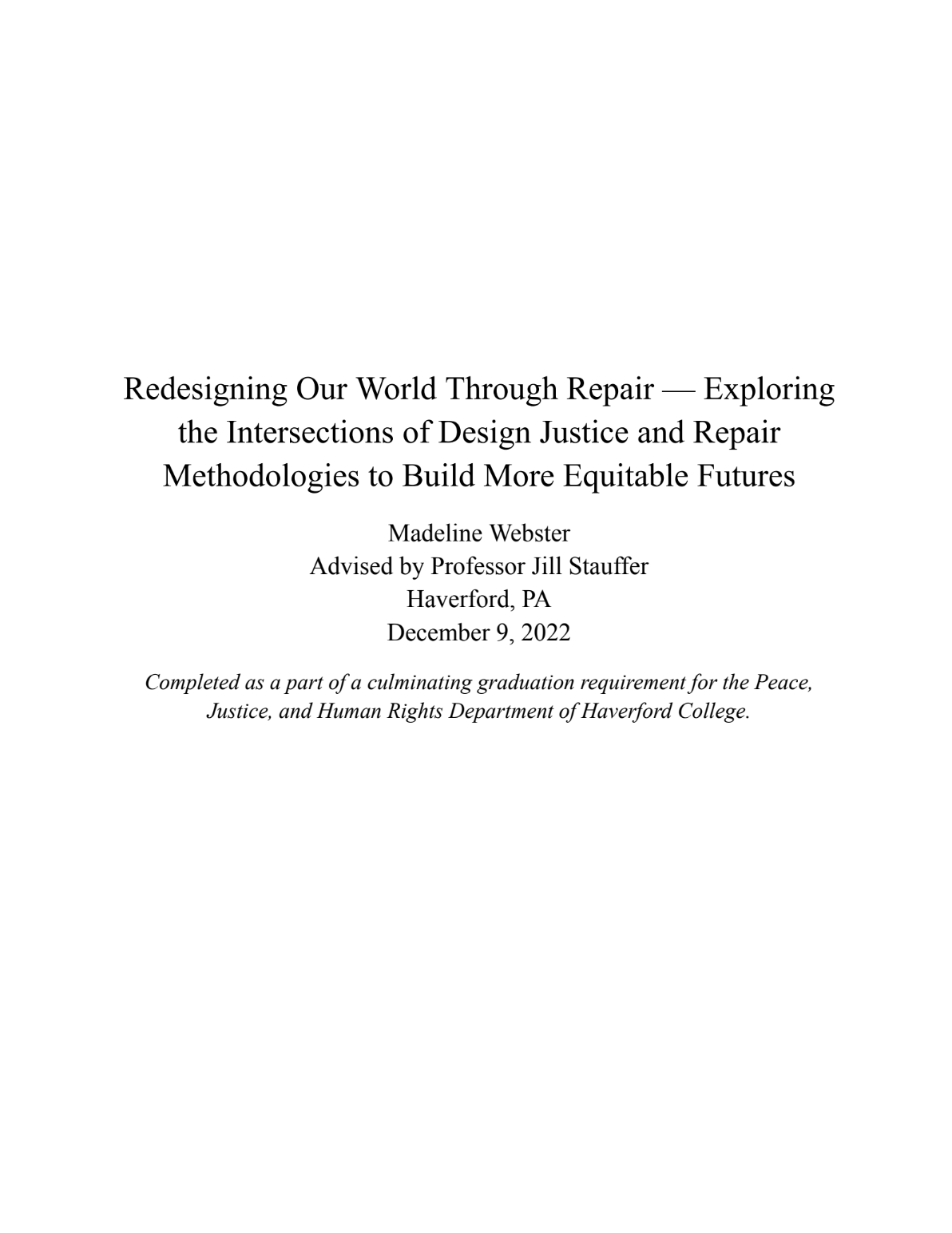Design Justice & Repair Research
Role: B.S. Candidate
Duration: 6 months
Skills: Scholarly Research and Writing, Thesis Defense, Community Teaching and Presentation
Project Context
The work below represents several months of scholarly research exploring the intersection of design justice and restorative justice methodologies. It advocates for the decolonization of contemporary design practices and the creation of more equitable product development frameworks, with a particular focus on technology design—examining algorithmic bias, surveillance systems, and early AI ethics.
Notably, this research was completed just prior to the public release of large language models (ChatGPT, Gemini, etc.), making its findings increasingly relevant to today’s conversations on responsible AI and inclusive design.
This project was completed as part of my undergraduate thesis at Haverford College, where it received the Peace, Justice, and Human Rights Award for Engaged Scholarship in Spring 2023.
My Thesis
The core argument of my thesis explores the intersection of design justice and restorative justice, examining how emerging restorative justice practices can inform and strengthen modern design justice initiatives. While the paper’s foundation is philosophical, much of its analysis focuses on the realities of contemporary product design. It argues that despite being rooted in ideals of equity, many current design practices have evolved to reinforce homogeneity and bias—particularly evident in examples such as algorithmic discrimination, the gendered design of voice assistants such as Alexa and Siri, and more.
The sections below outline the key themes and findings of the paper.
Some of my Key Sources
My work was guided by several pivotal scholars and texts whose contributions shaped both the theoretical and practical grounding of my research.
The cornerstone of this thesis is MIT’s Sasha Costanza-Chock’s Design Justice, a groundbreaking text that defines and illustrates the principles of design justice through a series of case studies. Costanza-Chock exposes how design discrimination manifests in everyday technologies and challenges prevailing myths within product and tech development that perpetuate exclusionary systems.
Their work is expanded upon by the Tendernet Collective’s Imagining Feminist Interfaces, which critiques the gendered nature of mainstream voice assistants (Google, Alexa, and Siri) and advocates for a practice of speculative design: radically reimagining future technologies that align with equitable, feminist visions.
These texts are further framed through the lens of Elizabeth V. Spelman’s Repair, a philosophical exploration of repair and restorative justice. While not explicitly situated within the design or technology fields, Spelman’s work provides a powerful framework for understanding how practices of repair, both literal and metaphorical, can illuminate the restorative potential of design justice. Together, these perspectives invite reflection on how we might not only repair design, but allow design itself to repair us.
Paper Breakdown
Redesigning Our World Through Repair — Exploring the Intersections of Design Justice and Repair Methodologies to Build More Equitable Futures
-
This section establishes design and repair as core human impulses; they are acts that inherently shape how we live and relate to the world around us. Drawing from thinkers like Victor Papanek, Anne-Marie Willis, and Elizabeth Spelman, I argue that humans are not only designers but also repairers by nature. Two roles that, when intertwined, reveal the potential to create more intentional, restorative forms of design.
-
Here I examine how modern design practices, particularly in technology, often reproduce structural inequities. Case studies such as algorithmic bias in the COMPAS sentencing software and gendered voice assistants like Siri and Alexa reveal how design can reinforce racism, sexism, and classism. These examples demonstrate that harm in design is rarely incidental — it’s a reflection of who gets to design and whose experiences are centered.
-
This section critiques the ways “universal design” has been co-opted by Silicon Valley into a “one size fits all” paradigm. While originally rooted in accessibility activism, universal design has been diluted into an ideal of neutrality that erases difference. I contrast “user universalization,” which excludes, with “personalized” systems that exploit data and reinforce surveillance capitalism. I argue that both fail to center equity.
-
Building on Elizabeth Spelman’s framing of justice as repair, I connect restorative justice practices to participatory design. This section argues that equitable design must begin with listening: identifying harms, centering those impacted, and co-designing solutions alongside communities rather than for them. In doing so, design becomes a collaborative act of repair — one that resists extractive or performative inclusivity.
-
The final chapter explores speculative design as a tool for envisioning radical futures free from systemic oppression. By uniting speculative thinking with philosophies of repair, we can both imagine and materially build worlds rooted in equity, healing, and continuity. Design becomes not only a means of creation but also a medium for reconciliation, a way to “repair the world while remaking it.”
-
In closing, I suggest that while neither design justice nor repair offers a single solution, together they present a framework for transformation. Through repair, we acknowledge harm; through design, we rebuild. When practiced together, they allow us to simultaneously heal our past, understand our present, and envision futures designed with, not merely for, the communities they serve.





